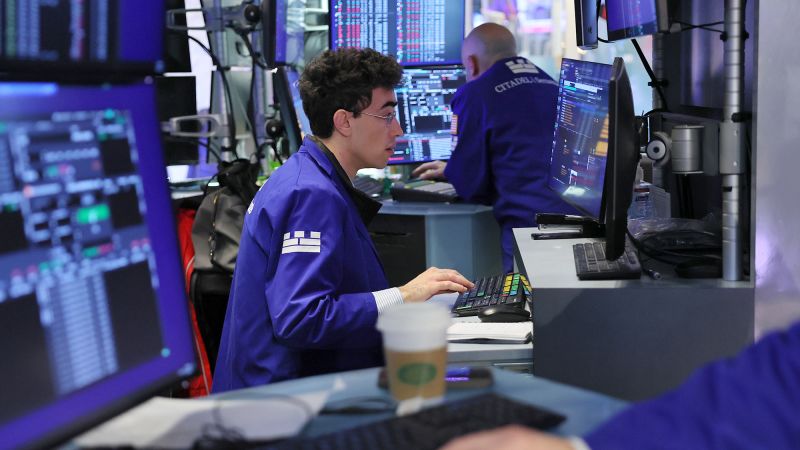In a significant shift of economic strategy, U.S. stock futures surged after President Donald Trump’s leading trade officials negotiated a surprising de-escalation in tensions between the U.S. and China over trade policies. This breakthrough, which occurred during discussions over the weekend, involved a substantial reduction in tariffs, easing fears of an impending U.S. recession. The news prompted immediate optimism in the market, reflecting a collective relief and hope among economists and investors that escalating tariffs could finally be curbed.
The Dow futures climbed a notable 1,000 points, marking a gain of approximately 2.4%, while the S&P 500 and Nasdaq futures saw even more pronounced increases of 3.1% and 4% respectively. This sharp rise indicated that American stocks were poised to recover all losses that had accumulated since Trump’s trade announcement on April 2. At that time, a 10% tariff had been levied on nearly all imported goods, eliciting a retaliatory response from China, which implemented a 125% tariff on U.S. products. The escalating trade war had threatened to unravel economic stability, leaving both American businesses and consumers anxious.
In the run-up to the talks, President Trump and Treasury Secretary Scott Bessent had acknowledged that the tariffs imposed on China had reached unsustainable levels. Therefore, the discussions held in Geneva between U.S. Trade Representative Jamieson Greer, Bessent, and their Chinese counterparts were marked by cautious optimism, though few were anticipating such a substantial agreement. Ultimately, both nations consented to reduce tariffs by 115 percentage points, effectively alleviating the trade pressure that had impacted American markets deeply.
Moreover, the negotiations resulted in a critical agreement aimed at preventing future tariff hikes between the two nations. This development suggested a potential end to the most severe confrontations of the trade war, which had raised concerns over supply shortages and inflation, particularly among American consumers. Financial experts like Henry Allen from Deutsche Bank highlighted that evidence indicating avoidance of a global recession became stronger following the announcement of these lowered tariffs.
Market reactions were overwhelmingly positive; Wall Street traders displayed a renewed appetite for riskier assets, and the U.S. dollar experienced a 1% uptick against a basket of currencies. The resurgence of U.S. oil prices, climbing 3.5% to $63 a barrel, underscored the impactful nature of the trade agreement. Conversely, gold—a traditional safe-haven asset—saw a decline of 3.9%, indicating a shift in investor confidence.
Particularly notable were tech stocks, which have been disproportionately affected by the trade war due to the intertwined nature of American and Chinese technology sectors. Companies such as Apple, Tesla, Nvidia, Amazon, and Intel experienced significant gains. In a parallel trend, luxury goods manufacturers, which had suffered downturns in recent months, also saw stock rebounds as consumer sentiment began to improve.
Secretary Bessent characterized the de-escalation talks as tough yet respectful, emphasizing the strength of the U.S. negotiating position. He indicated that China was increasingly reliant on the U.S. consumer market, particularly given its current economic struggles encompassing a housing crisis and diminished consumer spending. This dynamic placed the U.S. in a more advantageous negotiating stance.
Despite the optimistic news, Bessent remarked that this trade agreement was not a definitive policy change. Instead, it was a “pause” in ongoing negotiations to revise tariffs significantly and address strategic necessities for U.S. supply chains, including critical resources like medications and semiconductor chips. He expressed a vision of creating resilient domestic supply chains less reliant on China—an acknowledgment learned from vulnerabilities exposed during the COVID-19 pandemic.
Furthermore, on an international scale, the Trump administration aims to dismantle non-tariff trade barriers that have historically hindered American companies’ ability to operate abroad. This future-oriented focus signifies a shift not only in trade policy but also in economic strategy to enhance the competitiveness of U.S. industries globally.
In summary, the recent developments surrounding U.S.-China trade relations have fostered a sense of optimism in the market, highlighting the delicate balance of international negotiations, economic resilience, and the complex interdependencies that characterize global commerce. The shift away from aggressive tariffs suggests a reconciliatory approach that may ultimately benefit both economies, as they navigate through an era marked by heightened trade sensitivity.



